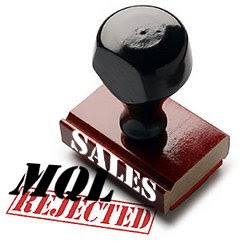
Marketing Qualified Leads: (MQLs for short) are leads that have been through your scoring/nurturing program and have scored high enough to warrant sales interaction.
No matter how accurate your scoring program is, no matter how relevent your nurturing programs are, sales will still reject a portion of these MQLs.
We often get asked what to do with these sales rejected MQL leads.
The answer really depends on why sales is rejecting the MQL in the first place.
WHY IS SALES REJECTING THE LEAD?
Let’s assume that the reason for sales rejection is NOT that their score is artificially high, that it is not due to the scoring program itself being out of whack.
Let's also assume that sales has actually communicated directly with the lead and discovered a red flag, which has caused sales to reject the lead.
The answer really depends on why sales is rejecting the MQL in the first place.
WHY IS SALES REJECTING THE LEAD?
Let’s assume that the reason for sales rejection is NOT that their score is artificially high, that it is not due to the scoring program itself being out of whack.
Let's also assume that sales has actually communicated directly with the lead and discovered a red flag, which has caused sales to reject the lead.
I have outlined some of the more common red flags and provided possible solutions to think about for each:
The lead is interested but doesn’t have the budget –
- Add the lead to a Sales Nurturing Program that includes promotions/discount programs/specific product advantages, etc. (This would be a marketing-driven campaign but the nurturing emails appear to have come from the sales rep, using their specific signatures)
- Option 1: Add them back into the main scoring program - Reset their implicit score to 0
- Option 2: Add them to a ‘Sales Nurturing’ scoring program
- Find out who the right decision maker is
- Add them to the main scoring program
- Reset the original lead’s implicit/explicit score to 0
- Adjust the scoring criteria’s “job Role/Job Title’ accordingly
- Add the original lead back into the main scoring program, allowing them to manage their email preferences
- Discover the correct solution
- Add the lead to a solution-specific nurturing campaign
- Option 1: Add them back into the main scoring program - Reset their implicit score to 0
- Option 2: Add them to a ‘Solution-Specific Nurturing’ scoring program
- Verify correct area of interest
- Add the lead to a solution-specific nurturing campaign
- Option 1: Add them back into the main scoring program - Reset their implicit score to 0
- Option 2: Add them to a ‘Solution-Specific Nurturing’ scoring program
- Ask if the lead would like to globally unsubscribe?
- If yes, do so
- If no, verify area of interest
- Add the lead to a solution-specific nurturing campaign
- Option 1: Add them back into the main scoring program - Reset their implicit score to 0
- Option 2: Add them to a ‘Solution-Specific Nurturing’ scoring program
Next Steps:
- Sit down with sales and come up with your own top 5 reasons why your sales team typically rejects MQLs
- Develop a process for managing each scenario
What to do with rejected MQLs is a highly evolved problem to have actually. For most companies this isn't even on the radar. So congratulate yourself for having a better problem than most!
Proper care and continued nurturing of these rejected MQLs at the level of detail described above takes planning but may well be worth the effort, especially considering the investment marketing has already made in actually getting them to the MQL stage in the first place.
Maybe we should modify the popular mantra, "No Lead Left Behind" and expand it to "No MQL Lead Left Behind".
Updated 5-8-12
Visit my brand new website and learn more about Lead Nurturing Best Practices
Steve Kellogg
-Demand Generation/Marketing Automation Consultant, Astadia
-Eloqua Certified Marketing Best Practices Consultant
On Twitter? Tweet this Post
 According to
According to 


